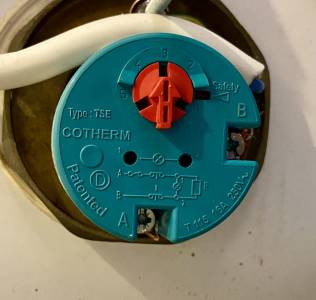Solar Diverter and faulty immersion thermostat = Accidental Sauna ***SERIOUS PROBLEM****
i recently installed a PV Mate to harvest unused energy from the PV (after it has finished charging the battery) - what i didnt know was the thermostat in my immersion heater was faulty.
the result was that the water in the cylinder just heated up uncontrolled and eventually it started to circulate up to the cold water storage tank (theyre both in the loft) -I only took action when the cold water (tank supplied) started delivering very hot water ! i had ignored the rise of temperature in the hot water being delivered - which was the first warning signal !!
the loft was like a bloody sauna, but thankfully we sorted the problem out easily enough (two new thermostats in the immersion heaters) but it could have been so different AND dangerous!
so if you do install a solar diverter just keep an eye on the hot water temp and if you notice a higher than normal temperature, dont ignore it, it could have disastrous consequences !
with a PV divert to run the immersion up to its max (even if the thermostat is working, the tank could reach 70C regularly) you must fit a blending valve to the hot output of the DHW tank to avoid potential scalding at the taps.
My octopus signup link https://share.octopus.energy/ebony-deer-230
210m2 house, Samsung 16kw Gen6 ASHP Self installed: Single circulation loop , PWM modulating pump.
My public ASHP stats: https://heatpumpmonitor.org/system/view?id=45
11.9kWp of PV
41kWh of Battery storage (3x Powerwall 2)
2x BEVs
Posted by: @iancalderbankwith a PV divert to run the immersion up to its max (even if the thermostat is working, the tank could reach 70C regularly) you must fit a blending valve to the hot output of the DHW tank to avoid potential scalding at the taps.
im sorry but im struggling to see the difference between the immersion being heated by solar harvesting or by standard electricity supply, surely it only heats to the level the thermostat is set to and then it shouldnt go any higher. 70C is way in excess of what it should be set to anyway, i set mine to under 65C and even that could scald an elderly or young person. i have thermostatic mixers on the shower though not admittedly on the bath, but then again, there are rarely old or young people using the bath.
I don’t dispute your suggestion that a blending valve (thermostatic valve) is a valuable safety addition but i am also surprised that when an immersion thermostat fails, why it doesn't fail safe and prevent water being heated.
Until last years November freeze, we had solar thermal connected to one of our DHW tank inputs. Sadly an ST panel bust, and I decided to give the other away. Anyway, every year in summer the tank would get silly hot (80C), and trip the immersion. There's a tiny little button to reset the safety trip on it - in addition to the adjustable trip it has.
Don't think our immersion is anything special. We use it every week to boost up to 65C. Otherwise the tank gets to 50C with the gshp on Go elec. Could perhaps be a bit lower, but Mrs RobL smiles every time she sees 50, while 40C is cause for words.
Immersion heater built-in thermostats are not that accurate. Mine is set to 65degC and cuts out when used with a solar PV diverter. However, the tank temperature indicates 54degC. There's quite a large stratification of temperature in the cylinder. Locally it is hot around and above the immersion, but much cooler elsewhere. That questions how effective the immersion is for Legionella protection. I've found the cylinder contents heat much more thoroughly and up to 55degC with the ASHP. The indicated temperature stays warmer for longer, indicating a much more even and thorough heating than using the immersion. If you consider the surface area of a 3kW immersion element vs the surface area of the heating coil, much more even and consistent heating would be expected with the coil. Heating tanks with hot outlet at the top and cold fill at the bottom are designed with intentional thermal stratification, to avoid cold water inlet cooling the hot water outlet down as much as possible. That's good for your hot water supply, but bad for Legionella protection.
@misterb, that sounds crazy and dangerous. What I find intriguing about solar diverters is that, as long as there is electricity to divert, they will happily continue doing so until instructed to stop.
Regarding our immersion heater on the HW tank, once you remove the protective cap, you'll find a dial that can be set between 1 and 5. Setting it to 5 is risky because the tank temperature exceeds 75°C, making the water scalding when you open the hot water tap. On sunny days, we often choose 4, which maintains the temperature at about 60°C, allowing the heat pump to perform a Legionnaires cycle purge. For most of the year, we keep it at 3, ensuring that the immersion heater doesn't allow the water to heat above 50°C. This is acceptable because our heat pump heats the water to 44°C, and the solar diverter further raises the temperature.
Get a copy of The Ultimate Guide to Heat Pumps
Subscribe and follow our YouTube channel!
thanks, i just have settings in degrees and have set them to just over 60C
re my solar diverter, i also have PV and a 14.3kw storage battery - the PV system is independant of the storage battery as it was installed under the FiT scheme, which means i also have two inverters! but it all works together. i have installed the CT clamp for the solar diverter after the CT clamp for the batteries, which means that any excess solar not being used by the house will charge the battery, then when thats full the excess solar will divert to to the hot water cylinder, when the thermostat kicks in and no longer requires heat then it just passes to the grid.
i do have two immersion heaters in my hot water tank and my solar diverter has two 'outs;, i have set the top immersion as the primary and the lower immersion as the secondary.
at least i know what the danger signs are should something similar happen, excessively hot water from either tap! i am also into the habit of turning the hot water off when we are away for longer than a day or two, though more of a cost saving exercise than a safety one!
the solar diverter is a recent purchase to try to squeeze as much free stuff as i can from the PV, it may yet be removed after 12 months if it doesnt behave as i hope !
- 26 Forums
- 2,364 Topics
- 53.6 K Posts
- 239 Online
- 6,029 Members
Join Us!
Worth Watching
Latest Posts
-
RE: Octopus Cosy Heat Pump Owners & Discussion Thread
Yes. In addition or instead. The point us that trv b...
By JamesPa , 15 hours ago
-
-
RE: ASHP sizing - value of Heat Transfer Coefficient
@toodles Hi, my friend recently made a video about heat...
By HeatPumpMe , 21 hours ago
-

How long will your energy contract last?
Some heat pump tariffs don’t run as long as a heat pu...
By Toodles , 2 days ago
-

@morgan They are unsupervised these days, can’t get the...
By Toodles , 2 days ago
-
-

RE: Setback savings - fact or fiction?
Exactly. We only need to compare conditions, to decide ...
By cathodeRay , 3 days ago
-
RE: Balancing financial efficiency and comfort using the Octopus Cosy tariff
I found because I have very low heat loss I can set bac...
By RadWhisperer , 3 days ago
-
RE: Need Help Optimising My Rushed ECO4 Install: 12kW Bosch Heat Pump
Welcome @mickamills We too have an oversized 12kW Sa...
By Old_Scientist , 3 days ago
-
RE: My Powerwall 3 Consumes 3-4 kWh/Day in Self-Consumption: Is This Normal?
@caron I can confirm that the power usage of the PW3 is...
By Old_Scientist , 3 days ago
-
RE: Speedcomfort radiator fans
Thats true, but having tried (and succeeded) in constru...
By JamesPa , 3 days ago
-
RE: Solis S6-EH1P8K-L-PLUS – Why I Chose It and What I’ve Learned So Far
@bash brilliant, thanks for the feedback
By energy9165 , 4 days ago
-

RE: Heat Pump Heats the House… But It’s Not Cosy. Emitter Changes or System Tweak?
@alastair There I was, feeling grumpy, he said “Cheer u...
By Toodles , 4 days ago
-
RE: Grant Aerona: Is there a setting to keep the 2-port valve open during pump blockade
Depends on OAT. Mine cycles at OAT>10 and of course...
By JamesPa , 4 days ago
-
RE: New Fogstar 15.5kWh upright solution
@transparent My conclusion is as you have noted, tha...
By Bash , 4 days ago
-
RE: Mitsubishi Ecodan R290 10kW performance
And to you too. Wishing you a very enjoyable festive s...
By Sheriff Fatman , 4 days ago
-

RE: External pipework insulation
They do? But that isn't apparent from the photos we'r...
By Transparent , 4 days ago
-

RE: Say hello and introduce yourself
@velcro welcome to the forums. Please feel free start a...
By Mars , 4 days ago
-
Daikin EDLA11D3V3 DHW Settings
I have a newly installed EDLA11D3V3 which I'm still get...
By Velcro , 5 days ago
-
RE: Midea ASHP – how to set weather compensation
@curlykatie did you get sorted with this?
By MickaMills , 5 days ago





